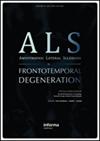主题4体内实验模型
IF 2.5
4区 医学
Q2 CLINICAL NEUROLOGY
Amyotrophic Lateral Sclerosis and Frontotemporal Degeneration
Pub Date : 2019-10-31
DOI:10.1080/21678421.2019.1646992
引用次数: 1
摘要
背景:在90%的肌萎缩侧索硬化症(ALS)病例中,疾病是散发的,其余10%是家族性的。许多基因都与这种疾病有关。下一代测序的使用增加了常规诊断中分析的基因数量。然而,这种增加提出了在越来越多的als相关基因中解释遗传变异的问题。变异分类是基于多因素的组合分析。其中,功能分析为致病性解释提供了有力的论据。目的:我们开发了一种简单的动物模型,斑马鱼,用于通过常规基因检测确定的候选变异致病性的功能分析。方法:通过mRNA注射在斑马鱼1细胞期卵中短暂过表达不同的ALS相关遗传变异。western blot验证蛋白过表达。胚胎死亡率、发育迟缓和形态异常在发育的头两天内进行了评估。用共聚焦显微镜对2日龄幼虫的轴突长度进行了分析,研究了细胞表型。采用接触诱发反应法研究了5日龄幼虫的运动表型。结果:该模型通过分析已描述的ALS突变SOD1-Gly93Ala和OPTN Glu478Gly得到了验证。这种突变蛋白的过度表达引起轴突缩短和过早的轴突分支,以及预期的运动性能障碍。我们在注射SOD1-WT的鱼类中未观察到这些畸变。我们的模型探索了在als患者中观察到的两个候选变异:SOD1 NM_000454.4:c。p.Glu134del和OPTN NM_021980.4:c。[1475t>g], p. lu92arg。这两种变体的过表达引起了形态异常和运动障碍,表明这些变体在als患者中有致病作用。讨论与结论:我们首次建立了一种简单的动物模型——斑马鱼,用于变异致病性的功能分析,以协助ALS的分子诊断。我们的模型已被用于评估SOD1和OPTN候选变异的致病性,从而改进基因检测的解释。本文章由计算机程序翻译,如有差异,请以英文原文为准。
Theme 4 In vivo experimental models
Background: In 90% of Amyotrophic Lateral Sclerosis (ALS) cases, the disease is sporadic, the remaining 10% being familial. Many genes have been associated with the disease. The use of next generation sequencing has allowed increasing the number of genes analysed in routine diagnostics. However, this increase raises the issue of genetic variants interpretation within a growing number of ALS-associated-genes. Variant classification is based on a combinatory analysis of multiple factors. Among them, functional analyses provide strong arguments on pathogenicity interpretation.Objectives: We developed a simple animal model, the Zebrafish, for the functional analysis of candidate variants pathogenicity identified by routine genetic testing.Methods: Transient overexpression of different ALS associated genetic variants has been performed by mRNA injection in 1-cell stage zebrafish eggs. Validation of protein overexpression has been done by western blot. Embryos mortality, developmental delay and morphological abnormalities have been assessed within the first two days of development. Cellular phenotype has been investigated by the analysis of axonal length of 2-days old larvae with confocal microscopy. Motor phenotype of 5-days old larvae has been explored by touched-evoked response assay.Results: The model has been validated by the analysis of well-described ALS mutations, SOD1-Gly93Ala and OPTN Glu478Gly. Overexpression of this mutated protein was shown to provoke a shortening of axons and a premature axonal branching, as well as an impairment of motor performances as expected. We did not observe these aberrations in SOD1-WT injected fishes. Two candidate variants observed in ALS-patients have been explored with our model: SOD1 NM_000454.4:c.400_402del, p.Glu134del and OPTN NM_021980.4:c.1475T > G, p. Leu492Arg. Overexpression of both variants induced morphological abnormalities and motor impairment, suggesting a pathogenic involvement of these variants in ALS-patients.Discussion and conclusions: We developed for the first time a simple animal model, the Zebrafish, useful for the functional analysis of variant pathogenicity in order to assist ALS molecular diagnosis. Our model has been used to assess the pathogenicity of SOD1 and OPTN candidate variants, allowing to improve genetic testing interpretation.
求助全文
通过发布文献求助,成功后即可免费获取论文全文。
去求助
来源期刊

Amyotrophic Lateral Sclerosis and Frontotemporal Degeneration
CLINICAL NEUROLOGY-
CiteScore
5.40
自引率
10.70%
发文量
64
期刊介绍:
Amyotrophic Lateral Sclerosis and Frontotemporal Degeneration is an exciting new initiative. It represents a timely expansion of the journal Amyotrophic Lateral Sclerosis in response to the clinical, imaging pathological and genetic overlap between ALS and frontotemporal dementia. The expanded journal provides outstanding coverage of research in a wide range of issues related to motor neuron diseases, especially ALS (Lou Gehrig’s disease) and cognitive decline associated with frontotemporal degeneration. The journal also covers related disorders of the neuroaxis when relevant to these core conditions.
 求助内容:
求助内容: 应助结果提醒方式:
应助结果提醒方式:


